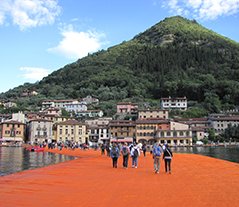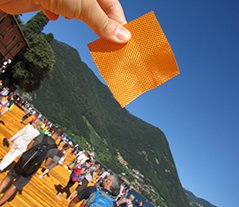 Married artists Christo and Jeanne-Claude have created stunning works of environmental art together for decades. From wrapping Berlin’s Reichstag with a tarp in 1995 to placing brightly colored gates through New York City’s Central Park in 2005, their art has always been about creating unique experiences and recreating familiar places. Their latest project, entitled The Floating Piers, will be on display from June 18th to July 3rd in Lake Iseo, a small lake located about 60 miles from Milan in the Lombardy region of northern Italy. Previous art produced by the couple in Italy includes Spoleto’s Wrapped Fountain and Wrapped Medieval Tower in 1968, Milan’s Wrapped Monuments in 1970, and Rome’s The Wall – Wrapped Roman Wall from 1973 to 1974.
Married artists Christo and Jeanne-Claude have created stunning works of environmental art together for decades. From wrapping Berlin’s Reichstag with a tarp in 1995 to placing brightly colored gates through New York City’s Central Park in 2005, their art has always been about creating unique experiences and recreating familiar places. Their latest project, entitled The Floating Piers, will be on display from June 18th to July 3rd in Lake Iseo, a small lake located about 60 miles from Milan in the Lombardy region of northern Italy. Previous art produced by the couple in Italy includes Spoleto’s Wrapped Fountain and Wrapped Medieval Tower in 1968, Milan’s Wrapped Monuments in 1970, and Rome’s The Wall – Wrapped Roman Wall from 1973 to 1974.
Though Jeanne-Claude passed away in 2009 after suffering a brain aneurysm, Christo continues to realize the duo’s previously conceived projects. The Floating Piers was originally designed by the couple in 1970, but an appropriate location for the work could not be found at that time. Many years later in 2014, Christo travelled to Italy’s northern lake district and found Lake Iseo to be the perfect place to host this ambitious artwork. Shelving artistic ideas to eventually realize them at a later date is not an uncommon practice for Christo and Jeanne-Claude as much of their work has been stalled due to the inability of the artists to receive the proper permission to build at their chosen site. Thankfully, this was not the case with The Floating Piers since Christo was able to receive permission to build the artwork rather quickly with the help of Germano Celant, a prominent Italian art historian and critic who is also the project director for The Floating Piers.
 The artwork itself consists of 200,000 large cubes made of polyethylene that are wrapped in bright yellow nylon fabric. The result is a network of 50 foot wide piers that just barely rise above the surface of the water allowing visitors to seemingly walk on the water for about two miles. These piers will connect the town of Sulzano on the mainland to the islands of Monte Isola and San Paolo, which are situated within the lake. Christo’s intent is to create a real connection between visitors and the surrounding nature—the wind, water, and sun are all integral parts of experiencing The Floating Piers. In addition, a sense of urgency and impermanence surrounds the installation due to its brevity and the fact that every part of it will be industrially recycled upon its closure on July 3rd. This ensures that once the installation is over, the project will live on in the memory of the people that were able to experience it.
The artwork itself consists of 200,000 large cubes made of polyethylene that are wrapped in bright yellow nylon fabric. The result is a network of 50 foot wide piers that just barely rise above the surface of the water allowing visitors to seemingly walk on the water for about two miles. These piers will connect the town of Sulzano on the mainland to the islands of Monte Isola and San Paolo, which are situated within the lake. Christo’s intent is to create a real connection between visitors and the surrounding nature—the wind, water, and sun are all integral parts of experiencing The Floating Piers. In addition, a sense of urgency and impermanence surrounds the installation due to its brevity and the fact that every part of it will be industrially recycled upon its closure on July 3rd. This ensures that once the installation is over, the project will live on in the memory of the people that were able to experience it.
The Floating Piers, which is completely free of charge to every visitor, is an amazing opportunity to explore Lake Iseo and the surrounding area. The lake is part of northern Italy’s famed lake district, but it has long been overshadowed by larger lakes such as Lake Como, Lake Maggiore, and Lake Garda. However, the pristine waters of Lake Iseo and the lush green mountains that encompass it are just as charming as the natural surroundings of the larger lakes. In addition, the lake is a gateway to the eminent Franciacorta wine region and there is a collection of renowned prehistoric rock carvings located in the Camonica Valley near the lake. Lake Iseo is also home to the largest lake island in Europe, Monte Isola, where eleven villages filled with striking art and architecture can be found. Thanks to The Floating Piers, visitors will be able to walk from the town of Sulzano to Monte Isola to admire the island and its unique culture. The island is normally accessible via ferry, but The Floating Piers allow visitors to experience the beauty of the island and the lake in a new way.
Ultimately, Christo’s upcoming installation in Lake Iseo has thrown this unassuming, but breathtaking lake, into the international spotlight. There is hope that this increased attention will lead the international community to recognize the value of this previously overlooked area. Should you find yourself in Lombardy while this truly unique installation is open, be sure to stop by and experience it!